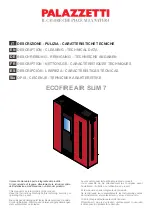
The installation must be completed in accordance with current National and European Standards and Local
Codes. It should be noted that the requirements and these publications may be superceded during the life of
this manual.
B.S. 5410 Part 1 Oil Installations
The Building Regulations:
Part J England, Wales.
Part F Section III Scotland
Part L Northern Ireland
Part J Ireland
The Control of Pollution (Oil) Regulations:
B.S. 7671: Requirements for Electrical Regulations
Safety Document 635: The Electricity at Work Regulations.
Safety, Health and Welfare at Work Act for Ireland, England, Wales and Scotland.
STOVE OPERATION INSTRUCTIONS
FUELS
USE ONLY 28 SECOND VISCOSITY KEROSENE
FUEL OIL TO B.S. 2869 PART 2 CLASS C2 OR
EQUIVALENT.
VENTILATION REQUIREMENTS
If there is an air extraction fan/s, tumble dryer or any
other air using appliance fitted in the room or adjacent
rooms to where this stove is installed, additional air
vents must be provided to prevent the performance
of the stove being affected when the fan/s are running
at their maximum setting with all external doors and
windows closed. All vents must be kept clear and free
of any blockages.
We recommend that air supply to extract fan/s be lo-
cated where it can serve the fan/s, without the air sup-
ply passing through the area where the appliance is
installed.
NOTE:
THE STOVE MUST BE COMMISSIONED
BY AN AUTHORISED STANLEY SERVICE AGENT
PRIOR TO THE FIRST OPERATION.
15
This appliance is hot while in operation and retains its
heat for a long period of time after use. Children,
aged or infirm persons should be supervised at all
times and should not be allowed to touch the hot
working surfaces while in use or until the appliance
has thoroughly cooled.
Keep combustible materials and soft furnishings well
away from the stove. See Clearance to Combustibles
section.
WARNING:
Unauthorised modification of the stove will void
the product warranty. Do not tamper with the set-
tings on the oil valve or draught regulator, only
replacement parts recommended by the manufac-
turer should be fitted to this stove.
FLUE DRAUGHT
Flue draught is the upward movement of air / flue
gases within the chimney/flue. Flue draught/ buoy-
ancy can occur naturally in a dwelling due to the dif-
ferential between internal air density and atmospheric
air density , it is increased where the chimney is
heated by the flue gases emitted from a stove. As the
air within the chimney is heated it expands and be-
comes lighter, the flue draught effect comes from the
lighter air rising. Where a wind blows across a flue
terminal it should also induce a draught in the chim-
ney. In some circumstances where the internal tem-
perature is close to external temperature and wind
speed is very low, natural draught may not be
present.
Where a natural flue draught is not present prior to
lighting, it will be necessary to prime the flue as the
initial energy generated within the burner may not be
sufficient to overcome the resistance within the flue,
which would lead to the fire using up the available
oxygen within the stove and then the flames would
extinguish after a short period.
PRIMING THE FLUE
Open the door of the stove, place a firelighter on the
right hand side under the vent as indicated in figure
below. Ignite the firelighter and close the door. Wait a
period of 10- 15 minutes before lighting the stove.
See Fig 18.
LIGHTING THE STOVE
Before commencing the lighting procedure there
should not be any oil in the burn pot. Do not relight a
burner that is hot, i.e. has been lighting within the last
three hours.
Remove any soot deposit on the glass with a soft dry
cloth when the glass is cold, minor deposits on the






































